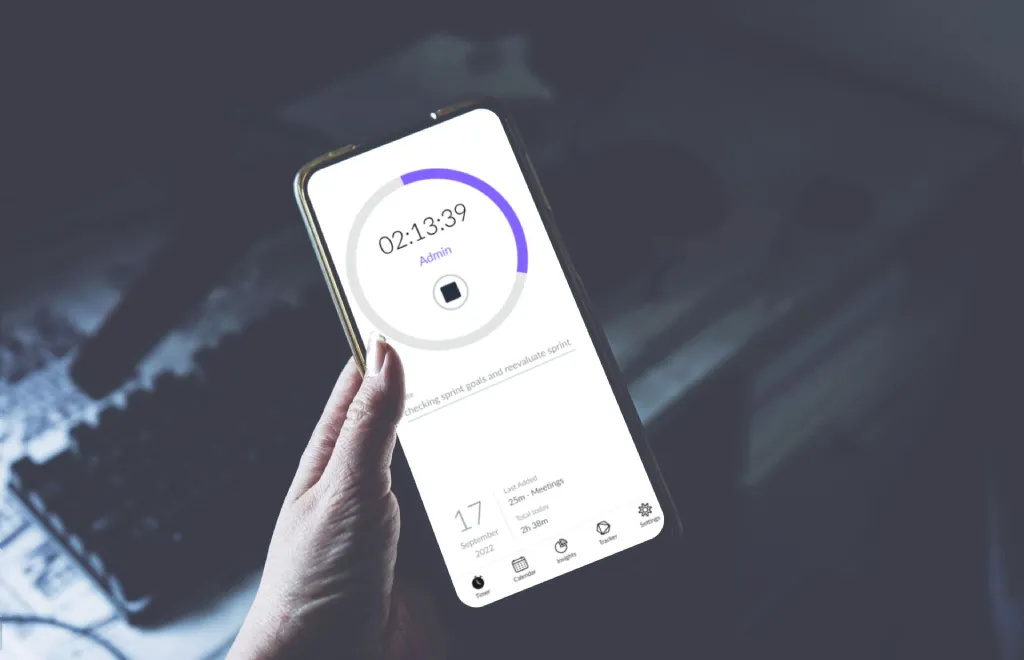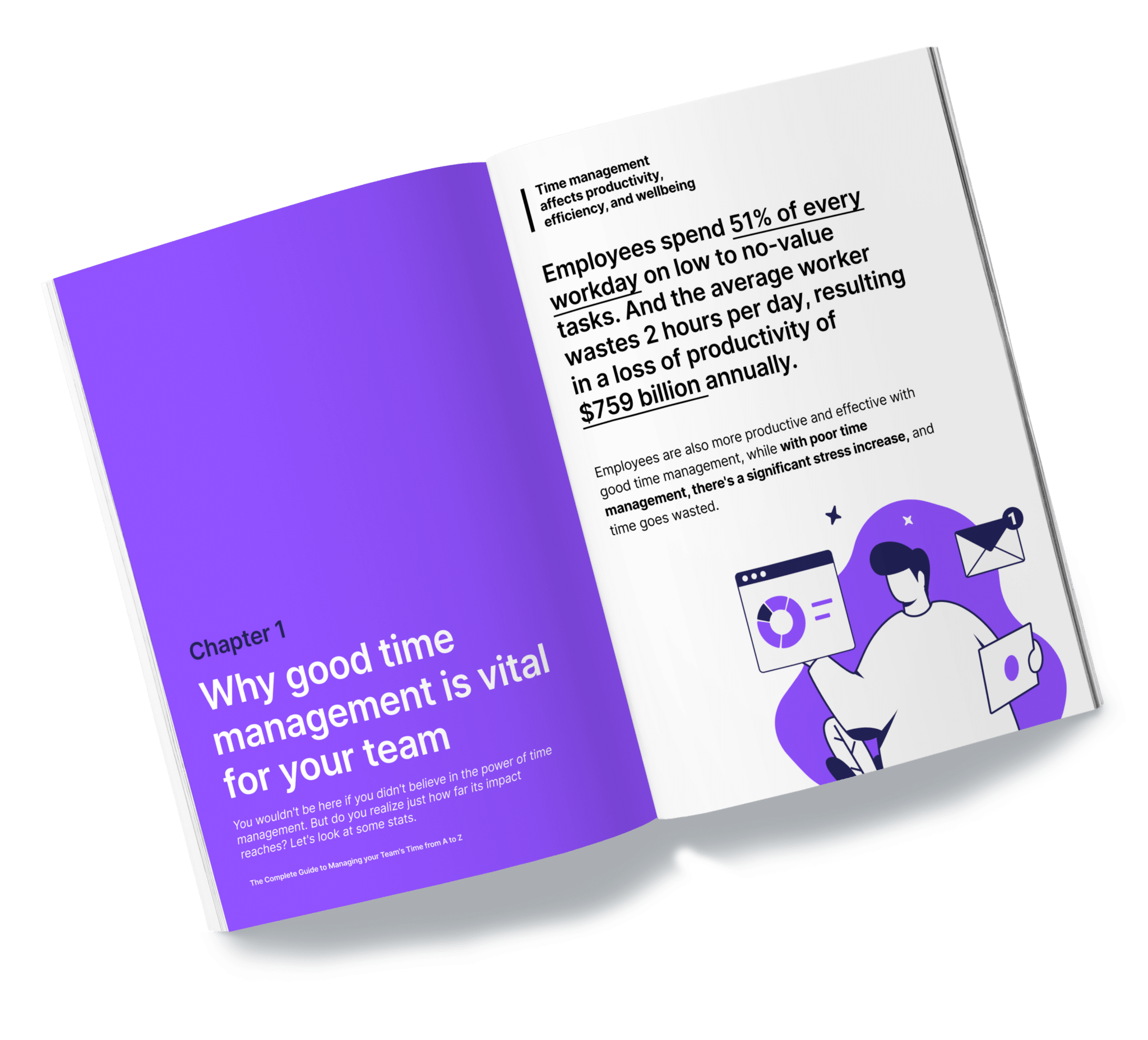12 Best Time Tracking Tips in 2024
60% of a team’s time goes to doing things that aren’t working, according to Asana’s research. You don’t want time-tracking to fall into that category, too.
Whether time tracking is a necessity or a choice for making informed decisions, you need to do it wisely and efficiently.
So, before your attention drifts, here’s what I’ll walk you through in this article: 12 tips to track time and get the most out of it, as well as understanding how a time-tracking solution can help you achieve your objectives.

Tracking time doesn’t have to be complicated.
With Timeular you can track time automatically, effortlessly and securely. With AI by your side.
Time tracking tools give you access to crucial information to understand your and your team’s performance and productivity levels. However, you need to understand that implementing it into your daily routine can be tricky.
Keeping track of your time is an extra job that most employees don’t want to do, but there are many ways to make it easier.
But how? Let’s get into it.
The 12 best time tracking tips
1. Understand why it’s important to track time for your team
First, don’t do it just because you vaguely think it might work or be helpful.
Before you start time tracking, you should have clarity on why you need it. Here are some questions you can use to understand your time-tracking needs:
- Where do we spend most of our time?
- Are my team members overworking?
- Which projects and tasks are the most profitable ones?
- Which clients are the less profitable?
- Are we billing correctly or missing some lucrative opportunities?
- What are the main time-wasting activities for my team?
- Where in the day the fatigue kicks in, and my productivity levels drop?
- How do I know what to focus on to scale my business?

2. Get your team onboard
This is a vital step. If your team doesn’t understand the benefits, they will only see it as extra work.
So, you’d better get them onboard and invested in time tracking before implementing some intricate time tracking system.
Here are four simple tactics you can use to persuade them:
- Show a case study or some actual information: find a company or a friend that’s already using a time tracking tool and ask them to share their key learnings after they started using a time tracking app, for example.
- If you don’t have any examples at hand, have a look at Timeular’s success stories with time tracking best practices from users.
- Share your timesheets: The easiest way to make a point is to prove that you’re aware of the process yourself, as well as share time-tracking best practices. Track your time for one or two weeks before sharing the results with your team.
- Explain the benefits: give your team at least three key points about how time tracking would improve both their work and the company’s results.
Below there are some examples of benefits.
- Streamlined payroll: When teams are using a time tracking software, they can seamlessly transfer data from the app to their payroll solution and minimize steps and human error.
- More accurate project estimates: When managers know how long it takes for their teams to complete tasks, they can accurately predict how long a project will take and reduce scope creep.
- Better team management: You can ensure that your team is working on tasks that align with their skillset and aren’t overworking themselves.
Ask for their opinions: request whether your team has concerns about time tracking and find the best solution together.

3. Find a simple and user-friendly time tracker
Choose your time-tracking software wisely. Although you might first think of time tracking templates as the right way to simplify time tracking, there’s another alternative, that is far more user-friendly: an automated time-tracking app.
Filters to consider in choosing a time-tracking tool:
- Assess if it has an intuitive dashboard, easy accessibility, accurate monitoring, and automation features.
- Look at all the time tracking software features and how you can make use of them;
- Check the compatibility and integrations with different devices and software, and of course, the price;
You could try multiple tools, but I’ll briefly introduce you to my tool of choice: Timeular – an automatic and effortless time-tracking tool loved by over 100,000 happy users.
Timeular is a versatile time-recording app that offers users flexible ways of tracking and managing their time effectively.
With Timeular, you and your team can:
- speed up the time tracking process by automatically tracking with simple keyboard shortcuts or a time tracking cube;
- get automated time entry suggestions based on your calendar events generated by AI;
- automate time reporting with just a few clicks;
- keep project budgets in control with budget notifications;
- track overtime hours and use Timeular for leave tracking to achieve balanced workloads and accurate reports;
- track non billable and billable time with one click;
- integrate Timeular with over 3000 other tools of your choice;
- keep data secure, as all your data is stored locally, with 100% GDPR compliance at the core.
This software is also very flexible and adapts to your working conditions: whether you’re working in the office or you and your team are working remotely, Timeular backs you up with all the information you need to take your business to the next level.

Start tracking your time accurately with zero effort
“We have become 20% more profitable because everyone is in the habit of time tracking.” – Richard Wingfield, Head Geek at Envision Design
4. Keep it simple
This is one of the best tips for time tracking, but also one of the most underrated: keep.it.simple.
When creating a structured time-tracking framework, it’s easy to get carried away with all the possibilities and future reporting options. Instead of creating tens of different activity categories and sub-tasks, try to keep it as simple as possible.
To start, track a maximum of three activities with your team. From there, start adding more activities once the team has fully adopted time tracking.
To add a touch of sophistication to your time-tracking structure, create tags that people can add when logging their time. A tag is a shared label that team members can use to categorize their time entries. For example, a tag could be #reactive or #proactive work.
Tags should serve as an add-on for time tracking data, making it easier to remember which tasks the time was spent on exactly.

5. Create a troubleshooting system
It’s perfectly normal to mess things up at the beginning when you’re still learning.
Imagine you’ve completed the task of planning a project together with a client. Is it supposed to be logged under the category “Meeting,” “Planning,” or “Work for clients”?
Well, to avoid this kind of confusion, establish clear rules of which activity falls under which project and make sure the whole team is aware. It can be super helpful for your team if you create a Q&A document or a Slack thread where everyone can submit questions about logging their time.
You can also create a shared file with examples of how to track different tasks and activities. Add explanations as to why each one falls under a specific category. As well, make sure you review time sheets regularly to check whether everyone has logged their time correctly.
6. Establish rules
To avoid complete chaos, establish user rights that prevent all users from editing your time-tracking system. You don’t want every single person to create task categories randomly. You, or a person designated by you for that purpose, should be the only ones able to create categories so that everything is coherent.
You also need to ensure everyone has at least 10 minutes a day to log their time. Otherwise, by the end of the month, lazy colleagues will have the whole month empty, and it will lead to chaos in your time-tracking framework. If you realize someone is struggling, offer help, as taking up a new habit is difficult.
Ask regularly your team members whether they grasp the new system and if they need additional guidance.
Note: I’m not suggesting employee monitoring but rather identifying time tracking trouble within your team and sharing as many time tracking best practices regularly.
Timeular, for example, offers consulting sessions when new teams start tracking time and helps them establish the rules, along with time tracking best practices.

7. Say goodbye to spreadsheets
Excel was the almighty tool for quite a while, helping businesses become more efficient and helping with employee work hours tracking while enhancing productivity.
But not anymore. Manually filling time entries in Excel time sheets is time-wasting and often leads to human errors.
Nowadays, there are so many better options to track your time, such as a cloud-based time tracking tool that also compiles your reports in addition to systematically tracking your team’s time.
What are the benefits of using time-tracking software instead of Excel? Here they are:
- It’s a lot easier: you don’t need to send tens of emails to collect everyone’s time sheets. All the data is one click away in your time-tracking tool.
- There are fewer errors: you’ll instantly notice if something doesn’t add up by keeping track in an automated tool. Whether the time entries or the expected duration of a project is suspiciously low or if some employees are outperforming others by a huge margin.
- No more double data entry: instead of logging your team’s time on spreadsheets and then compiling it into a work report, you can get automatically created reports inside your work management tool.
- Use your tracker anytime, anywhere: while Excel spreadsheets live on our PCs, a cloud-based tool makes your time sheets accessible anywhere and anytime.

8. Use time blocking
Time blocking involves dedicating a certain workday period to a specific task. It’s like breaking your daily to-do list into chunks of time. We could also call these timed slots to work on tasks or projects. That means eliminating distractions and using all that time to get as much work done.
However, time blocking largely depends on your industry and whether you work independently or collaborate with other team members.
Therefore, it may be tough to time-block some workspaces and jobs because they are so dynamic. Remember, this planning method should improve your workday, not make it more stressful.
Ensure that the nature of projects within your team or company is suitable for this technique, and if so, use it.
Even Elon Musk’s 5-minute rule is based on time-blocking principles; just saying.
- TIP: Download our time blocking templates for free.

9. Prioritize items in your to-do lists
Be it personal time tracking or tracking hours for work, one of the fundamental tools for time management is the almighty to-do list.
Simple yet powerful, it consolidates all you need to do in one place – from the tiniest tasks to the biggest ones.
Once you have the list, you can set priorities and tackle the important ones first. Prioritizing that list ensures that you focus on the most important items rather than giving in to the temptation of working on less important items because they are easier to do.
Moreover, using a to-do list enables you to mark off the tasks you have completed. At the end of the day, instead of feeling overwhelmed with deadlines looming on you, ticking tasks off your list gives you a sense of accomplishment.
We also wrote about the best prioritization methods and top workload prioritization tools to help you categorize your workload.

Free eBook: How to improve your time management skills
Get your free copy of the eBook and learn how to improve time management at work to boost productivity
Find the best prioritization methods to prioritize your workload.
10. Break large tasks into smaller ones
When working on an extensive and arduous project, it’s easy to feel overwhelmed by the magnitude of the tasks you’re responsible for completing. This feeling can prevent you from making progress, damaging your morale and making your workload seem almost impossible.
But just as you’d eat a large meal in small bites, you can get through any task, no matter how long and complicated, if you can break it down into manageable pieces. Once you’ve done so, you only need to address those pieces individually.
Therefore, a work measurement system that breaks up tasks on an hourly and daily basis will be able to achieve a larger task outline or long-term objectives in a much easier way.

11. Automate tasks
In any recent guide with time-tracking best practices, you’ll come across automation.
Gathering data manually is rather monotonous and repetitive, and in all fairness, there’s no longer added value to it.
Therefore, there are a few things that are super important to automate and will allow you to save a lot of time.
Just out of curiosity, did you know that without a task automation app, an average employee spends about 3 hours a day repeating the same tedious task instead of focusing on more creative projects? This has resulted in decreased work productivity, effectiveness, and motivation for many companies everywhere.
Reports show that companies that adopted work automation had nearly 60% of their employees saving six or more hours a week when some repetitive aspects of their jobs were automated. This is possible because workplace automation can handle about 45% of repetitive tasks.
Automating tasks is an excellent efficiency booster. Find out more tips to improve business efficiency
Automating tasks is an excelent efficiency booster. Find out more tips to improve business efficiency.
12. Use data to make decisions
The ability to make crucial decisions using time-tracking software becomes fact-based and provides good inputs for more intelligent management in general. Overall, this leads to improvement within the company, as the end-user understands their work style and what needs to improve.
With time tracking, a manager comprehends the skill and ability issues within the team and what kind of changes must be done to make things work smoothly. Time tracking also helps in understanding a team’s dynamics while segmenting performance across multiple dimensions.
Performances will always vary depending on many factors, such as skillsets, education, managers, or an employee’s location. However, rich data generated by time-tracking software will provide insights needed to run operations to a high capacity and maximum efficiency.
Did you know that time tracking will help you make better time estimations?
Did you know that time tracking will help you make better time estimations?
Conclusion
As stated, time tracking can be super effective and help you improve your productivity and overall results.
But it should be done right, based on relevant time tracking best practices. Hopefully, you learned the best time-tracking tips and got the most out of them.
There’s no singular way to track time, so you’re not expected to follow every single one of the rules mentioned. Focus on finding the tracking system, rules, and practices that fit your business and needs, as well as the needs of your employees.
Simply choosing a piece of time management software just isn’t enough. Once you decide on the system, to get the best results, ensure you are taught by specialists on how to make the set-up and the time tracking rules that benefit you most.

Tracking time doesn’t have to be complicated.
With Timeular you can track time automatically, effortlessly and securely. With AI by your side.
FAQs
Yes, time tracking does improve your productivity and overall performance. It helps measure your productivity, both for personal time tracking and work. Once measured, it helps you and your team to develop a sense of accountability and urgency during the work process. The time-tracking collected data can tell you what needs to be optimized to become more productive.
Yes, employee time tracking is completely legal, unlike time monitoring. Timeular, for example, is built with anti-surveillance and 100% GDPR compliance at the core. It stores data only on your local computer, and managers have access to the time entries of an employee with a 24-hour delay. We all know employees aren’t into time tracking unless they don’t feel monitored in real time.
There are different ways to track your time efficiently, such as a paper planner, online planner, time tracking app, or a simple spreadsheet. The most important thing at the end of the day is to implement a tracking time system that suits your workflow. I can’t help myself, but I suggest that it be automated, too!
You might be interested in: